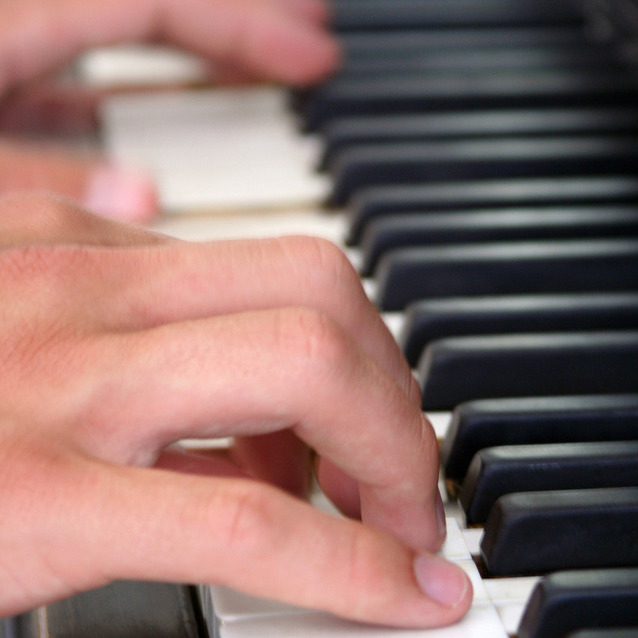While I was still a student at the University of Michigan pursuing a Doctor of Musical Arts degree in piano performance, a friend asked if I would teach her boyfriend – a rank beginner – to play the piano. It had always been his dream to play, though I don’t recall why he wanted to learn (if I ever bothered to ask), but I assume he was a wanna-be rock and roll musician. I agreed to teach him as a favor to my friend.
We began with some basics like chords, scale patterns, and notation (this was in the days before the current crop of method books geared toward adults). In my haste to get started, I neglected to do a very simple test of this young man’s coordination. Turns out he couldn’t put fingers 1, 3 and 5 down simultaneously to play a chord. It was as if I had asked him to hop on one foot and juggle five bowling pins. Couldn’t do it! After four or five lessons he quit in frustration. Do I fault him for this? Not at all! This was my error. I could have done any number of things differently, including doing an evaluation of his coordination before starting; developing what he did well – like simple melodic patterns – and expanding on this via interesting repertoire; or deemphasizing reading in favor of playing by rote.
Fast forward to the present day. As a private teacher and a piano faculty member at Oakland University in Rochester, Michigan, my bread and butter students are intermediate and advanced. But occasionally I will still teach a beginning adult student. Far from being a burden, I enjoy it tremendously. These students are motivated to learn and practice, whether because they regretted quitting lessons as a child, have specific repertoire they want to study, or just want to keep their minds active. They usually have more flexible schedules for lesson times than pre-college students too. It also allows me get back to basics, to try new pedagogical techniques, and to enjoy their wonder of discovery. In the past, a student might come to me through the university for a three month semester of 12 lessons, and more recently through private inquiry. I take only some of these students, based on their background and goals.
Here’s my process. It’s not for everyone, but it’s what I have found to be most successful for me.
- Vetting – Determining whether to accept a student
“Beginner” is an ambiguous term. In fact, one of my newest students called himself a beginner, because he had only been playing for 4 years, but on his own he had learned quite well Chopin’s g minor ballade and Scriabin’s Etude in D# minor, Op. 8 #12! Still others have had lessons as a child, or had musical training in another instrument, so they could read at least one clef. After the failure teaching my friend’s boyfriend from my first example above, I have never taught an adult with absolutely no knowledge of music in some form or another. And for me, this is an important distinction. So for me, “beginner” comes with the assumption that there is some experience in music.
I also require a prospective student to have access to an acoustic piano vs a keyboard. For some, this is not an issue.
From there, I set up a free trial mini lesson to see if we are a good fit.
- The Interview – a mini lesson
After gathering some background information on a prospective adult student, and determining that it might be a good fit, I next offer a free mini lesson before either of us commits to ongoing lessons. This way I can discover the person’s skill set. If I haven’t already determined their motivation for taking lessons, I ask them point blank, “Why do you want to take lessons? Why do you want to learn to play the piano?” Their answer often provides the key for the focus of lessons if we both decide to go forward. I test coordination by asking them to play back simple patterns by rote with some rhythmic challenges, teaching them the lay of the piano to see how quickly they respond, and I find out what they already know about music in general and the piano specifically.
- Consider lessons every two weeks rather than weekly; organize their practice time
My adult students take an hour lesson, but sometimes every other week due to work schedules and limited practice time. Regardless of how often they take a lesson, it’s essential to show them how to organize their practice time.
- Lessons – Getting started, what to cover in each lesson
After introducing proper position at the piano, I’ll introduce one or two concepts at a time to avoid “circuit overload”. Generally, adult beginners understand mentally before they can coordinate their physical responses. With that in mind, I spend more time reinforcing a single new concept (ex., five finger and scale patterns, interval identification, chords) through musical examples and repertoire than I would with a young student; this gives them time to master the coordination before adding new movements. From the beginning, I stress listening and movement before reading notation, from common gestures to articulation.
Use a good adult-based method book as a supplement to what is covered in the lesson.
While I prefer to start students off without too much written material (unless their primary goal is to learn to sight-read more proficiently), instead focusing on physical movements and sound exploration, I do use method books to fill in gaps and as a reminder of principals covered in the lesson.
I’m not wedded to any single adult method, though I have used and like the Faber Adult series more often than others. I also very much like the Frances Clark Keyboard Musician for the Older Beginner, however it does move more quickly than the Faber, so I use this only when I feel the student has enough background to benefit from the faster pace.
Add supplemental repertoire based on the student’s musical preference and goals.
Use the student’s stated reason for coming back to or starting piano to find additional appropriate level repertoire that supports the new musical concept introduced in the lesson. I often use graded level music found on https://www.8notes.com/piano/ for this purpose, or sequenced repertoire books, such as those in the ABRSM or Keith Snell series, or Essential Keyboard Repertoire.
Use trusted Youtube videos to enhance reinforce areas of technique and musicianship, and to inspire further study.
I keep a list of my favorite youtube instructional videos and send these links to students for viewing between lessons. They are complementary to my own teaching, although may present these ideas differently. Some of my favorites are by Josh Wright and Graham Fitch, but there are many others. I also send students links to music I think they will like based on the initial interview, not only at their playing level but also more advanced. This helps their ear and their physical approach to the keyboard, and helps them develop a “wish list”.
Offer performance opportunities, both solo and duet.
While beginning students may feel shy about getting up in front of an audience, it is a good motivator for improvement. Rather than a recital, I hold monthly studio classes so these students can play for each other. We often do these in a home setting – mine or a student’s – as everyone is more relaxed. One way I get students to feel comfortable performing is to play duets with me, like Diabelli’s Op. 149 duets, available through imslp.org. The Primo part for all 28 pieces is in a five finger position in simple keys. No. 6 in C major is a favorite.
In my experience, teaching adult beginners can be as rewarding for the teacher as it is for the student.
#teaching

Rebecca Happel
Rebecca Happel holds DMA from the University of Michigan in piano performance. She teaches at Oakland University in Rochester, MI, and has also taught piano at Schoolcraft College in Livonia.



Comments are closed.